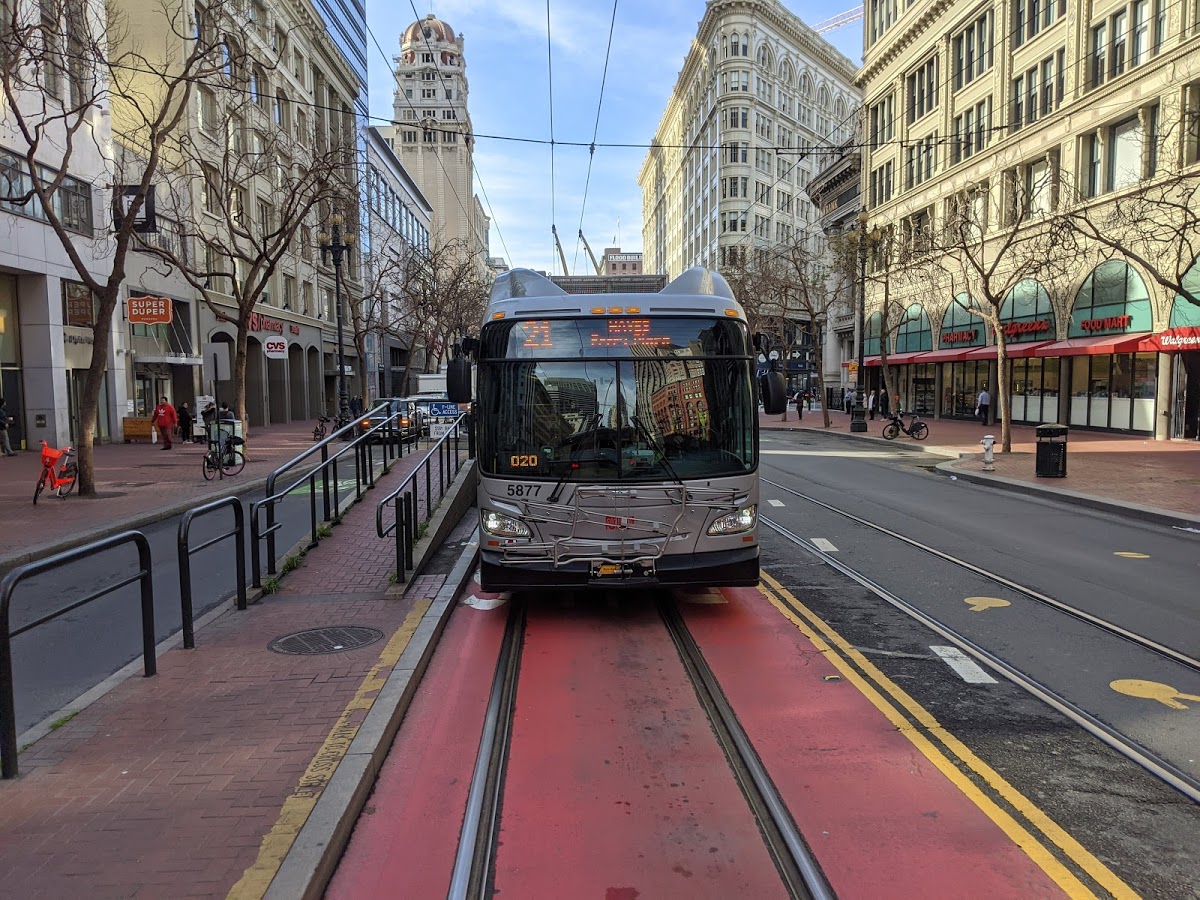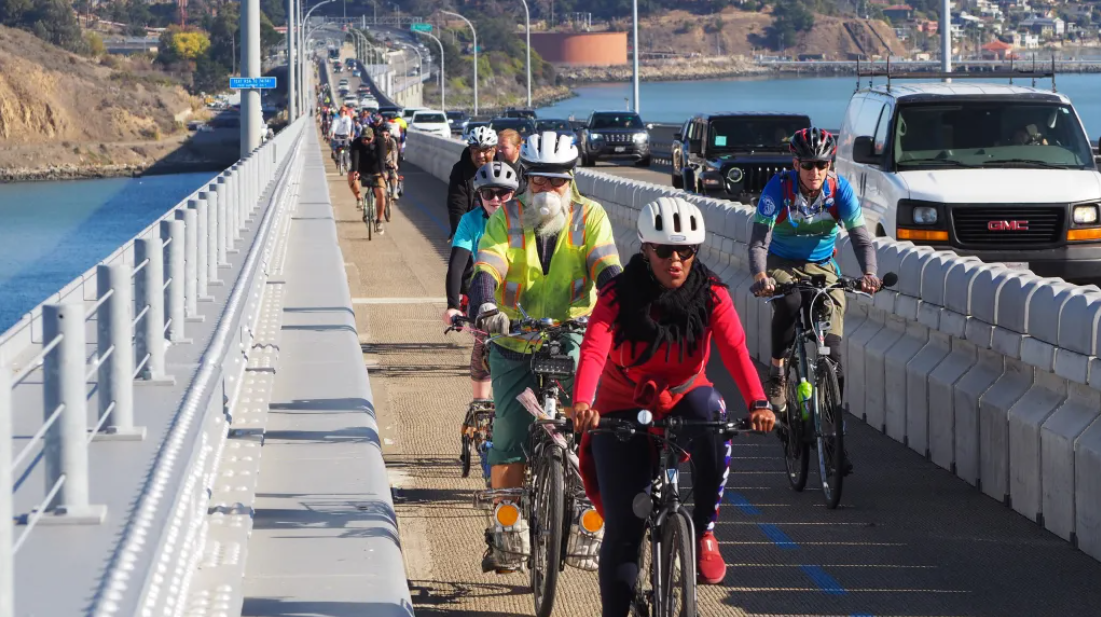S.F. Transit Riders Urge a “Yes” Vote on Measure L
2:34 PM PDT on October 31, 2022

Photo: Streetsblog/Rudick
Note: GJEL Accident Attorneys regularly sponsors coverage on Streetsblog San Francisco and Streetsblog California. Unless noted in the story, GJEL Accident Attorneys is not consulted for the content or editorial direction of the sponsored content.
Our city’s transit is struggling — and if the past two years of living through a pandemic have taught us anything, it is that no issue exists in a bubble. Poor transit and transit infrastructure means longer and more packed rides, less access to affordable housing, fewer opportunities for employment, worsening air pollution that leads to long-term health problems, and more. We can not afford to move backwards on these issues. That’s why San Francisco Transit Riders (SFTR) supports Measure L, and why we want you to vote “Yes” on the measure this November.
This past June, we came within 1.56% of the votes needed to pass Proposition A, a loss that stripped vital funds from SFTMA. Prop A would have helped San Francisco’s transit-dependent riders, those who are most burdened and most affected by unreliable, infrequent, and inaccessible transit. While the passage of Measure L cannot fill the gap left by Prop A’s failure, its passage is now even more critical. Measure L will help the city perform maintenance and repair, replace aging facilities, and keep paratransit running.
This past September our city celebrated Transit Month, and throughout the month the rallying cry we heard most frequently was how important Prop L is for the future of Muni. The measure provides funding for SFMTA, BART, and Caltrain to follow through on promises to improve and fix the problems that riders complain about — broken down buses, faulty train control that delays the subway, elevators and escalators that are out of service, rough and jarring rides — and would help the agencies rebuild and regain trust within the San Francisco community, something that is much needed.
We all know how hard our public transit was hit during the pandemic, and how much the city has struggled to rebuild and come back. In 2020, Muni canceled upwards of 80% of all service, and the lines that were operational were running fewer buses than normal. Route cancellations like the 2, 3, 6, 21, and 66, and shortened routes like the 43, 52, and 58, hit transit dependent and low mobility riders particularly hard, and further eroded trust that the public transportation system could be relied upon.
But even before the pandemic hit, our agencies were facing capital program shortages. In SFMTA’s case, a lack of funding over time resulted in a backlog of infrastructure replacements that now totals over $3.8 billion, $1.14 billion of which are transit critical assets. While agencies are careful to prioritize maintenance and replacements that keeps the systems safe, other systems like the Muni metro train control system languish. Facility replacements like Potrero Yard, bus replacements, elevator replacements, safe street initiatives, track and road work — all of them have faced delays against a lack of funds. Lack of maintenance and replacement of old systems has operational impacts, including service delays and skips; keeping our fleet in a state of good repair is essential to also not fall backwards on service restoration. Measure L won’t resolve SFMTA’s maintenance backlogs, but it will help keep them from getting substantially larger.
At the same time, we can’t lose sight of the future. Measure L will fund the Downtown Rail Extension, connecting rail from the current Caltrain station at 4th & King to under the Salesforce Transit Center. This will allow both Caltrain and, once it is complete, California High Speed Rail direct access to the center of downtown San Francisco. It’s vital that we make forward progress toward our climate goals as a state, and bringing High Speed Rail to San Francisco is part of that effort. Money will also be directed at core capacity improvement for both Muni Metro and the BART corridor in downtown.
Why do we need Measure L, isn’t there something else?
No. Our city has faced decades of disinvestment in public transit that has resulted in the inadequate service we have today. Measure L does not provide a magic wand to fix many decade's worth of problems, but it provides funding to address transit maintenance and enhancement, safe streets, paratransit, major transit problems, and more.
What’s the end result of passing Measure L for a daily rider like myself? Will it fix Muni’s problems right away?
Unfortunately, there is no immediate fix to all the issues that face our public transit today. Measure L is focused on capital funds. The money is targeted at infrastructure maintenance projects (60%) rather than new large projects (23%). It also funds important operational concerns (19%). Substantial paratransit funding comes from the sales tax, and a failure to reauthorize via Measure L means Muni will either need to reduce paratransit service and/or take that funding from other sources. At its base, Measure L will help stabilize Muni. It will not solve many of Muni structural issues, but its loss will destabilize the agency further.
So what exactly is Measure L?
Measure L is a new expenditure plan for the existing ½ cent sales tax for transportation passed in 1989, replacing the 2003 expenditure plan which is largely complete or running dry on funds due to early expenditure to cover for pandemic shortfalls. It does not raise the sales tax. L is projected to raise $2.6 billion over 30 years directly from the ½ cent sales tax, and projects raising an additional $22-24 billion in state and federal matching funds using the $2.6 billion as seed money. The measure requires two-thirds majority approval by San Francisco voters before it can be enacted. In short, the funding plan for the transportation sales tax is expiring and Measure L would approve a new spending plan, and continue the ½ cent sales tax for transportation for 30 years.
Does it include a new tax?
No, it does not. The ½ cent sales tax for transportation was passed by voters over three decades ago. This sales tax has since provided funding for public transit and street projects — including the Central Subway, Caltrain electrification, Geary and Van Ness Bus Rapid Transit, and the Presidio Parkway. In fact, you will keep paying the tax whether Measure L passes or not. Plus, on average, every dollar the sales tax raised by San Francisco has historically been matched by federal, state, and other sources. This makes Measure L a very efficient fund-raising tool.
But will we actually see these funds matched?
The SFCTA expects the $2.6 billion raised by Measure L to be multiplied 10x by matching funds, and in the end raise over $26 billion for transportation infrastructure investment. These matching funds are normally only available if the city has “seed” money, demonstrating local political will behind the projects. Measure L and the sales tax provide these seed funds.
Can’t the city seek these matching funds without the measure?
In most cases, no. Almost all of these dollars will be lost without the funds provided by Measure L.
Who created the expenditure plan?
For the first time, the expenditure plan was developed in collaboration with community advocates, residents, and non-profits like SFTR and Seniors and Disability Action, as part of the Expenditure Plan Advisory Committee (EPAC). Community outreach focused on Communities of Concern, including the Bayview and the Tenderloin. These community members and organizations worked with the county transportation authority, SFCTA, to craft the expenditure plan.
Break it down for me. What does the measure actually fund?
- 41% funds target rehabilitation, maintenance, replacement of old equipment, and station/access improvements
- For example: repairing and maintaining street pavement, traffic signals, and sidewalks citywide
- Transit improvements like electrifying Muni’s bus fleet, implementing transit signal priority, maintaining buses and trains so they operate safely and reliably, and increasing capacity on both Muni and BART to reduce crowding
- Replacement of the Muni Metro train control system
- 23% funds targeted at major transportation projects
- 47% of this particular money is going to reliability and core MUNI Rail and BART capacity
- Caltrain downtown rail extension; this will eventually support both Caltrain and high-speed rail directly into the Salesforce transit center.
- 19% funds target streets and Freeways
- Money for street resurfacing, rehabilitation and maintenance
- This includes money for neighborhood-level investments such as crosswalks, traffic calming, new and upgraded traffic signals, bicycle lanes, Safe Routes to School programs, and tree planting
- Express bus expansion
- 11% funds target Paratransit
- 6% funds Transportation System Development and Management
- Neighborhood and equity transportation programs
- Management of transportation demands
Transit is essential in San Francisco, and we need to fill the funding gap before it’s too late. That’s why SFTR is voting “Yes” on Measure L this November, and why you should too. SFTR will continue to engage with riders across the city to ensure riders are front and center when it comes to transit decision-making in a way that builds trust and accountability for SFMTA and other government entities. We are currently conducting a transit needs assessment in Bayview to identify the post-pandemic needs of riders in Southeast San Francisco and how they might translate to improved transit connections in the neighborhood. In addition, our transit planning, funding and regional policy working groups ensure our actions center the needs of riders.
Measure L presents an opportunity to invest in the transit system we need to meet our transportation, climate and equity goals and rebuild public trust. Let’s take that opportunity.
Read More:
Stay in touch
Sign up for our free newsletter
More from Streetsblog San Francisco
Commentary: Merchants Are Getting People Killed
The number one local obstruction to curbing traffic violence is commerce and merchant groups.




